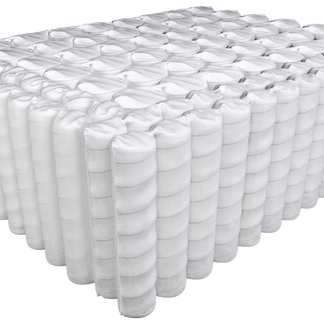
When it comes to spring mattresses, there’s a common misconception that all beds with springs inside them contain essentially the same types of springs in similar arrangements. This, however, could not be further from the truth, and pocketed spring mattresses most certainly feel nothing at all like innerspring mattresses.
Pocketed Springs vs. Innerspring: The Difference in a Nutshell
As we covered in our previous article on innerspring mattresses (which we recommend reading as a precursor to this blog on pocketed springs), innerspring beds contain a singular assembly of web-like interconnecting springs. While there is some variation in the types of innerspring technologies on today’s market, pocketed springs are drastically different in that they create a completely independent suspension system where no one spring is physically tied to (or impacted by) any other.
Who Invented the Pocketed Spring Mattress?
British-born inventor James Marshall invented what he called the Marshall coil in 1899, and the Marshall Mattress Company still continues to operate in the Canadian market to this very day. The name pocketed coil (or Spring in the case of Sherwood’s design) came about as result of the fabric encasement Marshall conceived to wrap each individual coil inside. This not only prevented any one coil from getting entangled with adjacent coils, but it also prevented the squeaking sound inherent to lower quality innerspring assemblies.
The Advantages
Pocketed springs by Sherwood provide a wide range of benefits that continue to make them popular with a growing number of mattress shoppers. As compared to innerspring, encased springs isolate motion transfer from one area of the bed to another. Married couples find this benefit especially helpful, since one partner can wake up to use the bathroom during the night without disturbing the other. Another significant advantage of pocketed springs is their unique ability to conform to the natural curvature of your body as you sleep. Whereas innersprings tend to provide support that’s less adaptive to pressure points, encased springs (i.e., pocketed springs) compress more in areas like your hips, while remaining tall and supportive in the crucial lower back area.
What to Look For
While most manufacturers of pocketed spring mattresses will rave about their 600-700 individually wrapped springs, this is standard for any pocketed spring queen-size bed. Even more important than the number of springs is the particular quality of each individual spring’s construction.
Sherwood Bedding’s line of Lumina® luxury mattresses is comprised of all heavy-gauge tempered steel springs that provide greater support and last longer than the vast majority of other springs on the market. Our quality pocketed spring mattresses also incorporate a unique 6-sided foam encasement construction that improve the mattress’ overall stability and expand its usable sleep surface by 14%.
For many of our customers, the startling difference between the feel of a Lumina® and a competitor’s pocketed spring mattress is just as drastic as comparing a standard innerspring with a pocketed spring design. If you haven’t yet had the chance to experience the Lumina® luxury/value combination for yourself, we invite you to visit a retailer near you to see what you’ve been missing.






Comments